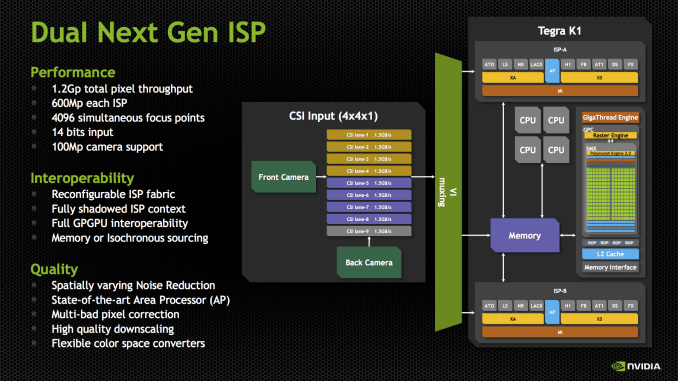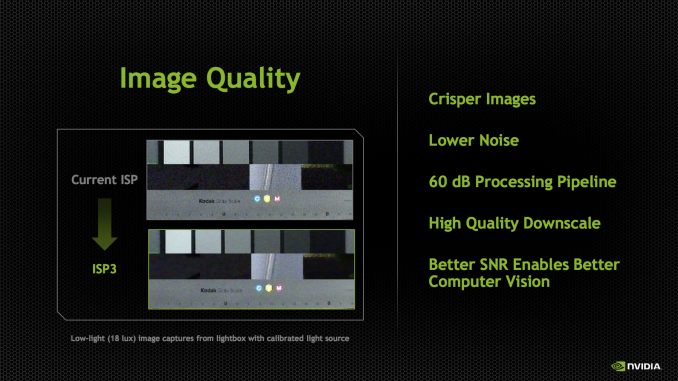NVIDIA Tegra K1 Preview & Architecture Analysis
by Brian Klug & Anand Lal Shimpi on January 6, 2014 6:31 AM ESTTegra K1 ISP & Video
NVIDIA’s Tegra K1 SoC also makes some dramatic improvements on the ISP side. We saw SoCs start arriving with two ISPs sometime in 2013, which allowed OEMs to deliver a host of new imaging experiences, like shot in shot video and simultaneous use of both front and rear cameras. With Tegra K1, NVIDIA is not only moving to two ISPs, but it’s also making ISP more of a first class citizen.
For those not familiar, ISP (Image Signal Processor) handles the imaging pipeline for still photos, video, and performs tasks like Bayer to RGB conversion (demosaicing), 3A (Autofocus, Auto Exposure, Auto white balance), noise reduction, lens correction, and so on. Although NVIDIA has always included an ISP onboard, I couldn’t shake the feeling that still imaging performance could’ve been better, especially in the few cases that allowed direct comparison (HTC One X). With Tegra K1, there’s more die area dedicated to ISP than in the past, and there are two of them to support the kind of dual camera applications that have quickly become popular.
Tegra K1 includes the third generation of NVIDIA’s ISP, capable of processing 600 MP/s on each ISP with 14 bit input, and support for up to 100 MP cameras. There are two of them, so NVIDIA quotes the total pixel throughput as up to 1.2 Gp/s. This is dramatically increased from Tegra 4, which supported up to 400 Mp/s at 10 bits per pixel. In addition the K1’s ISP now supports up to 4096 focus points, a 64x64 array, for its autofocus routine. The ISP also has better noise reduction, and local tone mapping, a feature we’ve also seen become popular for combining parts of images and recovering some of the dynamic range lost with ever shrinking pixel sizes.
Tegra K1 retains compatibility with the Chimera 1.0 features that we just saw in the Tegra Note 7, like object tracking, always-on HDR, slow motion capture, and full resolution burst, and adds more. NVIDIA has kept the Chimera brand for the K1 SoC, calling it Chimera 2.0, and envisions this architecture enabling things like better temporal pixel binning (combining 8 exposures from the CMOS to drive noise down further), faster panorama, video stabilization, and even better live preview with effects applied. The high level of Chimera seems to be the same – kernels that either run on the CPU, or on the GPU (ostensibly in CUDA this time) before or after the ISP and in a variety of image spaces (Bayer or RGB depending).
On the video side, Tegra K1 continues to support 2160p30 (4K or UHD video at 30FPS) encode and decode. Broken down another way, H.264 High Profile Level 5.1 decode and 4K H.264 High Profile 4.2 encode. The fact that there’s a Kepler next door made me suspect that NVENC was used for most of these tasks, but it turns out that NVIDIA still has discrete blocks for video encode of H.264, VP8, VC1, and others. These are the same video encode and decode blocks as what were used in Tegra 4, but with some further optimizations for power and efficiency. The Tegra K1 platform includes support for H.265 video decode as well, but this isn’t accelerated fully in hardware, rather the decode is split across NVENC and CPU.
NVIDIA showed off a K1 reference board doing 4Kp30 H.264 decode on an attached display, I didn’t notice any dropped frames. Of course that’s a given considering we saw the same thing on Tegra 4, but it’s still worth noting that the SoC is capable of driving 4K/UHD displays over eDP 1.4, LVDS and HDMI 1.4b.
The full GPIO breakdown for Tegra K1 includes essentially all the requisite connectivity you’d expect for a mobile SoC. For USB there’s 3 USB 2.0 ports, and 2 USB 3.0 ports. For storage Tegra K1 supports eMMC up to version 4.5.1, and there’s PCIe x4 which can be configured













88 Comments
View All Comments
blanarahul - Monday, January 6, 2014 - link
Quick question: Is it possible to build a 32-bit ARMv8 CPU core i.e. a ARMv8 core capable of running a 32-bit OS without using a hypervisor? That would really ease the transition to 64-bit for Android.blanarahul - Monday, January 6, 2014 - link
Anand, where do you find information about the revisions of Cortex cores??blanarahul - Monday, January 6, 2014 - link
Found it: http://infocenter.arm.com/help/index.jsp?topic=/co...klmx - Monday, January 6, 2014 - link
The real-time version of ARMv8 (ARMv8-R) is still 32-bit, and is capable of running a rich OS like Android, but I guess that's not the solution you had in minddroopaloop - Monday, January 6, 2014 - link
ARMv8 supports 2 different instruction sets; AArch32, and AArch64. AArch32 is basically the ARMv7 instruction set (read: 32bit). It is possible to run Android in AArch32. It is also possible to run the kernel in AArch64, and have AArch32 apps running on top which should help ease the transition to 64bit.Krysto - Monday, January 6, 2014 - link
How would using a 32-bit-only CPU ease the transition to 64-bit? ARMv8 supports both 32-bit and 64-bit modes by default (you can make it 64-bit-only later, though), so that's what needed for the "transition to be easier" - OEMs to just jump to ARMv8, even if the OS remains 32-bit.phoenix_rizzen - Monday, January 6, 2014 - link
This is exactly what Apple did with their A7 SoC. It's an ARMv8 CPU. It can run either a 64-bit or 32-bit version of iOS. If running the 64-bit version, it can run either 32-bit or 64-bit apps.Krysto - Monday, January 6, 2014 - link
That's what everyone will do. That's what I'm saying. It's the default. OEMs just need to switch to ARMv8, and that's it. It's up to Google to make Android 64-bit, and then to app devs to make their apps 64-bit, but neither is "necessary" for the transition to 64-bit CPUs.BMNify - Tuesday, January 7, 2014 - link
remember The Cortex-A15 and above also introduced full hardware accelerated virtualization so you could also run several versions of an OS concurrently too if you so wished and skillful enough to code your apps base libraries with good generic and fast inter process communications (xcore style)deltatux - Thursday, January 9, 2014 - link
Why would you need to build a 32-bit ARMv8 core? Android is highly portable, just recompile the entire thing to the aarch64 instruction set and you're good to go. Nearly all apps are written in Dalvik anyways which means you won't have to recompile those apps and ARMv8 in itself is backwards compatible with 32-bit just like how x86-64 is backwards compatible with the original 32-bit x86. So even if there are 32-bit native apps, they can easily run on 64-bit Android.NVIDIA has shown off Android 4.4 running on Denver in 64-bit mode, so 64-bit Android does exist and works out of the gate.